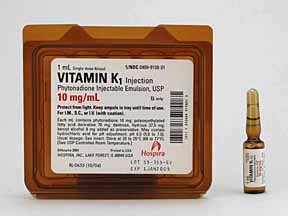
Phytonadione Coupons & Savings Card – Discount Prices from $20.95
Generic for: Mephyton, K 100, Superiorsource k1
My prescription
Edit
1ML of 10MG/ML, Vitamin K1 (1 Ampule)
Select pharmacy

CVS
$54.62
COUPON PRICE
Walgreens
$20.95
COUPON PRICE
Walmart
$21.22
COUPON PRICE
Albertsons
$32.00
COUPON PRICEFree Phytonadione Savings Card

Walgreens
$20.95
Show this coupon to your pharmacist
ID
LH900DE67B
PCN
HT
BIN
011867
GRP
LABH001
This coupon is not insurance
More prescriptions for vitamin K deficiency
More prescriptions for vitamin K deficiency
Phytonadione dosage forms
Dosage Quantity Price from Per unit 0.5ML 1 Vial $18.75 $18.75 0.5ML 2 Vials $31.20 $15.60 0.5ML 3 Vials $37.80 $12.60 1ML of 10MG/ML 1 Vial $36.07 $36.07 1ML of 10MG/ML 2 Vials $77.12 $38.56 1ML of 10MG/ML 3 Vials $116.46 $38.82
| Dosage | Quantity | Price from | Per unit |
|---|---|---|---|
| 0.5ML | 1 Vial | $18.75 | $18.75 |
| 0.5ML | 2 Vials | $31.20 | $15.60 |
| 0.5ML | 3 Vials | $37.80 | $12.60 |
| 1ML of 10MG/ML | 1 Vial | $36.07 | $36.07 |
| 1ML of 10MG/ML | 2 Vials | $77.12 | $38.56 |
| 1ML of 10MG/ML | 3 Vials | $116.46 | $38.82 |
Phytonadione Warnings
This medication requires careful consideration due to potential risks associated with its use. Please read the following safety information thoroughly and discuss any concerns with your healthcare provider.
Allergic Reactions: The injectable form of vitamin K can occasionally lead to severe, potentially fatal, allergic reactions, especially when administered into a muscle or vein. Injection under the skin or oral administration is preferred, unless your doctor determines the benefits outweigh the risks. Seek immediate medical assistance if you experience symptoms such as rash, itching, swelling, dizziness, or difficulty breathing.
Overdose Risks with Phytonadione: If you're using phytonadione to counteract blood thinning from anticoagulants like warfarin, be cautious of overdosage. Excessive use may reactivate clotting issues like atrial fibrillation, pulmonary embolism (PE), or deep vein thrombosis (DVT), which you initially sought to prevent. Regular monitoring of your blood tests is essential to ensure the dose remains appropriate for your condition. Always adhere to the prescribed dosage to avoid complications.
While contraindications are not specified, it remains crucial to follow your healthcare provider's guidance closely. Your safety is a priority, and understanding these risks helps in making informed decisions about your treatment.
Phytonadione Side Effects
Common side effects:
- pain at the injection site
- swelling at the injection site
- soreness at the injection site
- temporary flushing sensation
- changes in taste
- dizziness
- rapid or weak heartbeat
- sweating
- shortness of breath
- bluish discoloration of the lips, skin, or nails
Serious side effects:
- low blood pressure
- elevated bilirubin levels in newborns
- rash
- itching
- swelling of the face, tongue, or throat
- severe dizziness
- trouble breathing
